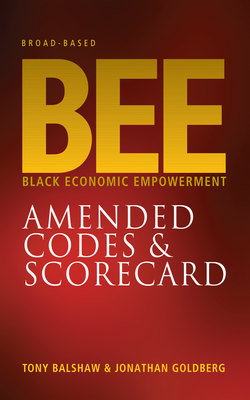Читать книгу Broad-Based BEE - Jonathan Goldberg - Страница 8
На сайте Литреса книга снята с продажи.
BEE IN A NUTSHELL
ОглавлениеEssentially, the practical working of broad-based BEE requires a business to ensure that it measures its broad-based BEE empowerment status based on the Amended Codes of Good Practice.
The broad-based BEE status of an entity will be based on the broad-based BEE points scored using the Generic Scorecard. The Status, based on the overall score achieved, will be evaluated using the following table which comprises of eight Contribution levels and related Recognition levels:
| Contribution Level | Qualification points using the Generic Scorecard | Broad-based BEE Recognition Level |
| Level 1 contributor | ≥100 | 135% |
| Level 2 contributor | ≥95 but <100 | 125% |
| Level 3 contributor | ≥90 but <95 | 110% |
| Level 4 contributor | ≥80 but <90 | 100% |
| Level 5 contributor | ≥75 but <80 | 80% |
| Level 6 contributor | ≥70 but <75 | 60% |
| Level 7 contributor | ≥55 but <70 | 50% |
| Level 8 contributor | ≥40 but <55 | 10% |
| Non-compliant contributor | <40 | 0% |
An entity that scores less than 40 points is deemed not to have a BEE Status.
The broad-based BEE Status of an entity is measured across the five Elements of ownership, management control, skills development, supplier and enterprise development, and socio-economic development.
The BEE Status is used by an entity’s customers (including government) to whom the businesses supply goods and services to seek good BEE points. Government and quasi-government agencies are compelled to apply the Generic Broad-Based BEE Scorecard and to obtain the broad-based BEE Status of businesses with whom they transact in procuring goods and services or, for example, issuing concessions and licences. These certificates will be valid for a period of one year.
The purpose of broad-based BEE is to play a meaningful role in South Africa’s economic transformation and ensure sustainable future growth and profitability. With this in mind, broad-based BEE is aimed across the board, at shareholders, customers, employees, suppliers and the community at large.
It is likely that the competitive advantage of empowerment will have only a limited lifespan.
The starting point will be to determine whether a business, for a range of reasons, will be affected negatively as a result of not complying with BEE legislation.
This question is ever more relevant under the new Codes. Is it still worth the time, effort and cost to produce an acceptable scorecard for an entity. We believe the first rationale for the implementation of broad-based BEE, the altruistic driver, by entities is largely gone.
It is important to remember that the Act applies to the public sector and public entities directly and therefore has only an indirect effect on businesses insofar as they have dealings with government bodies. There will be a cascade effect on private sector entities.
There are three qualifying thresholds for businesses to determine the basis of measurement to be used in determining their broad-based BEE Scorecard status and recognition level.
It is important to establish upfront which of the following categories will be used for measuring an entity’s broad-based BEE compliance:
